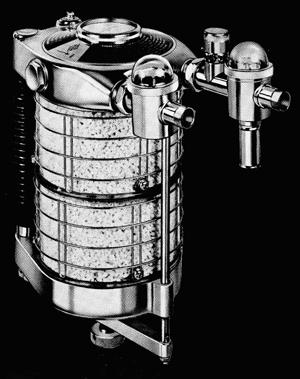Elimination of Carbon Dioxide
Elimination of Carbon Dioxide
Open and semiopen breathing systems eliminate carbon dioxide by venting all exhaled gases to the atmosphere. Semiclosed and closed breathing systems eliminate carbon dioxide by chemical neutralization. Chemical neutralization is accomplished by directing the exhaled gases through a carbon dioxide absorber, which consists of a canister (usually transparent) containing carbon dioxide absorbent granule (Figure 3.7). Gas flow through the absorber during exhalation is usually from top to bottom. A space at the base of the absorber allows the collection of dust and water.
Carbon Dioxide Absorbents: Soda Lime
Soda lime granules consist of water, calcium hydroxide, and small amounts of sodium and potassium hydroxide that serve as activators. Soda lime granules fragment easily and produce alkaline dust, which can lead to bronchospasm if inhaled. Silica is added to the granules to provide hardness and minimize alkaline dust formation. Neutralization of carbon dioxide with soda lime begins with reaction of carbon dioxide with water present in the soda lime granules and the subsequent formation of carbonic acid. Carbonic acid then reacts with the hydroxides present in the soda lime granules to form carbonates (with bicarbonates as intermediates), water, and heat. The water formed from the neutralization of carbon dioxide, the water present in the soda lime granules, and the water condensed from the patient's exhaled gases leach the alkaline bases from the soda lime granules and produce slurry containing NaOH and KOH in the bottom of the canister.

Soda-lime is a mixture of 94% calcium hydroxide, 5% sodium hydroxide and 1% potassium hydroxide. Carbon dioxide absorption occurs by the following chemical reactions:
H2O + CO2 = H2CO3
NaOH + H2CO3 = NaHCO3 + H2O
2NaHCO3 + Ca(OH)2 = 2NaOH + CaCO3 + H2O
Sign of efficiency of carboondioxide neutralization
- Warmness of the Canister
- Presence of moisture
- Presence of original color of the absorbent granules
Different absorber have different color, therefore we have to check the color before filling to canister.
Heat of Neutralization
The water formed by the neutralization of carbon dioxide with soda lime is useful for humidifying the gases and for dissipating some of the heat generated in these exothermic reactions. The heat generated during the neutralization of carbon dioxide can be detected by warmness of the canister. Failure of the canister to become warm should alert the anesthesia provider to the possibility that chemical neutralization of carbon dioxide is not taking place.
Efficiency of Carbon Dioxide Neutralization
Is influenced by the size of the carbon dioxide absorbent granules and the presence or absence of channeling in the carbon dioxide canister. Absorbent efficiency increases as absorbent granule size decreases because the total surface area coming in contact with carbon dioxide increases. The granular size of carbon dioxide absorbents in anesthesia practice is between 4 and 8 mesh, a size at which absorbent efficiency is maximal with minimal resistance. Channeling is the preferential passage of exhaled gases through the carbon dioxide absorber canister via pathways of low resistance such that the bulk of the carbon dioxide absorbent granules are bypassed. Channeling resulting from loose packing of absorbent granules can be minimized by gently shaking the canister before use to ensure firm packing of the absorbent granules. We have to change the carboondioxide absorber when it is exhausted which is manifested by complete change of original color (e,g, from pink to white or from white to purple depending on the original color), absence of moisture and warmness in the canister.